Introduction
When QoR Modern Watercolor was introduced to the painting world in 2014, we were so delighted with the color intensity and workability that we overlooked introducing the mediums and additives that were an integral part of the introduction of the line. So although six years later, we hope to make up for that neglect by taking a deeper dive to define and investigate the uses of the QoR Watercolor Medium, Synthetic Ox Gall, and Lift Aid TM. In fact, while researching these mediums, additives, and aids we have found that even traditional products within these categories are often overlooked in the watercolor world. This article hopes to shed more light on these three important lightfast products. QoR Watercolor Medium may be used to increase the strength, body, and gloss of watercolor paint. The additive Synthetic Ox Gall is a wetting agent that changes how diluted watercolor moves over or absorbs into the surface. Lift Aid is a transparent aid which, if applied and allowed to dry before being covered with watercolor, facilitates lifting of even staining colors. In a retail store, all three will be placed with “watercolor mediums.” These products can assist in techniques and might provoke new avenues of exploration. As with any new material, we recommend practice and experimentation before employing one of these in your paintings.
QoR Watercolor Medium
QoR Watercolor Medium contains Aquazol, which serves as QoR’s binder. It is a translucent medium with a slight amber color not noticeable when applied thinly, diluted, or mixed with color. This medium may be added directly to watercolor, mixed into the water used to dilute paint, and/or put in the water used to pre-wet a painting surface. Using a lot of this medium will add body to the paint and increase gloss. Using a little QoR Watercolor Medium in the paint or water can change the way watercolor moves and reacts, often creating smoother color areas when working wet-in-wet. What happens depends upon the binder and pigments in the paint, and how much QoR Watercolor Medium and water are being used (Images 2 & 3).
Large ratios of QoR Watercolor Medium added to paint—such as diluting the paint with the medium only—will decrease flow due to the viscosity of the medium in comparison with water. Mixes with higher ratios of Watercolor Medium also might dry more slowly. When present in a higher ratio, Watercolor Medium may create a glossy moisture-sensitive film, which could become sticky and adhere to other surfaces if the atmosphere is warm and humid. Take care when storing paintings with glossy areas. When brushed onto a surface full strength, Watercolor Medium may be used as a water-removable masking medium in a manner similar to Lift Aid (Image 5E and 5A). Both of these products provide softer shielding with less defined edges than the protection offered by QoR Masking Fluid.
QoR Synthetic Ox Gall
Have you ever painted diluted watercolor on a surface and had the paint bead up, or skip areas you intended to have color? This is probably a surface tension issue. Putting a little QoR Synthetic Ox Gall in water used to coat the painting surface and/or to dilute watercolor may help ‘wet out’ hard sized papers and less absorbent surfaces like acrylic gesso or YUPO®. Synthetic Ox Gall contains no binder, and so is an additive rather than a medium. It should not be used full strength.
QoR’s Synthetic Ox Gall can help because it is a wetting agent or surfactant that reduces tension between the diluted paint and the painting’s surface. It also may slow down drying slightly. Synthetic Ox Gall added to the paint or water changes the way watercolor moves. Our starting recommendation for dilution is 2-5 drops of Synthetic Ox Gall to 8 ounces of water. This mixture may increase movement and flow over a wet surface when brushed onto paper, used to dilute paint, or both. Since QoR can be quite lively when painted wet-in-wet, results may be subtle (Image 4).
QoR Lift Aid
QoR Lift Aid is an aid that can help remove dry watercolor if an artist plans ahead. Brush one or two coats over an area to be protected, whether it is the white of the paper or a previous application of color. Dry Lift Aid can create a temporary barrier between the surface beneath and the next layer of watercolor, making it easier to lift color from that last layer of paint once it is dry.
We recommend using QoR Lift Aid full strength and painting it either directly onto dry paper or over a dry wash. You may coat the entire paper or watercolor ground, or only part of the surface where you wish to lift paint. One or two layers should be enough, however, test to be sure. Carefully paint with diluted watercolor over the dry Lift Aid. Aggressive brushing will dissolve the Lift Aid and mix it into the paint, which reduces the medium’s ability to stop color staining. Allow the new layer of paint to dry completely.
To remove the Lift Aid, first use clean water and a brush to re-wet any color on the dry medium then gently blot off with a clean paper towel or rag. If care is not taken when removing this paint, the color can mix in and stain the paper (Image 5B). Once the paint is removed, use the same technique to remove the Lift Aid and reveal the bare paper or color underneath.
Please be aware that leaving Lift Aid on the paper will make additions of more layers of paint difficult, since the presence of the aid causes paint applied on top to lift and this can also stain the paper. The areas with Lift Aid might also look slightly different (Image 5C). The image sequence 5A –G shows the results of various approaches to reserving or reclaiming the white of the paper or an earlier area of color, including QoR Masking Fluid, Watercolor Medium, and Lift Aid.
Images of Some of Our Tests and Results:
All tests done on Fabriano Artistico 300 lb / 638 gsm Extra White Cold Pressed Watercolor Paper.
Image 2: Comparison of QoR Watercolor Medium and water used to dilute QoR Ultramarine Blue, on dry paper.
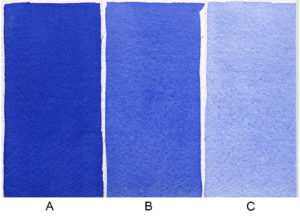
2 A, 2 B, 2 C: WATER ONLY used for dilution, with more water added as the washes move right.
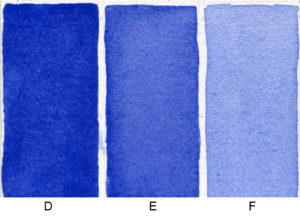
2 D: QoR Watercolor Medium only used to dilute paint, glossy surface is reflective and color more intense.
2 E, 2 F: Dilution with Watercolor Medium and water, with more water added to 2 F. Not readily visible in this image, the center wash’s (2 E) edges have intense color and a glossy surface.
Image 3: Comparison of Watercolor Medium with paint and water on shiny water-wet paper with QoR Ultramarine Blue. 
3 A: Paint diluted with Watercolor Medium only. 3 B: Paint diluted with water only. Notice the greater spread due to thinner viscosity of just water.
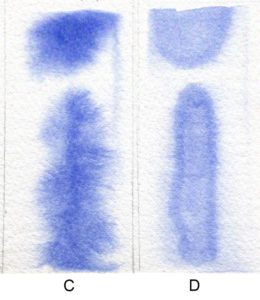
3 C: Paint diluted with 5 drops QoR Watercolor Medium to cup (8 ounces) of water. 3 D: Paint diluted with water ONLY. Just a small addition of Medium creates greater saturation and feathery spread.
Image 4: Comparison of QoR paints diluted with just water vs diluted with water and QoR Synthetic Ox Gall and brushed onto wet YUPO Heavy.
4 A: Brushed onto water-wet surface. 4 B: Brushed onto surface wet with mixture of 5 drops of QoR Synthetic Ox Gall to 1 cup of water.
Image 5: Using QoR Lift Aid to keep or reclaim the white of the paper with staining colors. Top row of tests: Lift Aid brushed over center square on paper and allowed to dry. Staining Nickel Azo Yellow brushed over the paper and Lift Aid. More information provided beneath the images below. Bottom row of tests: Nickel Azo was brushed over the entire surface and when it was dry Lift Aid was brushed over the center square. A blend of staining Phthalo Turquoise and Phthalo Green (Blue Shade) was brushed over the yellow and the Lift Aid. Each layer was allowed to dry before the next was applied. More information can be found beneath the images.

5 A: Top, two coats of Lift Aid applied to paper. Once dry, a yellow wash brushed over surface. Lift Aid removed when yellow was dry. Bottom, two coats of Lift Aid over yellow, followed by green paint. Lift Aid removed once green glaze was dry.
5 B: As with 5A, but only one coat of Lift Aid. Top, dry yellow paint over Lift Aid was not pre-removed, so paint mixed into Lift Aid during removal of the aid and stained the paper.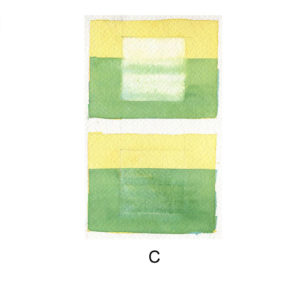 5 C: Top, results of painting on top of Lift Aid with a second glaze, then removing the Lift Aid. Bottom, Lift Aid remains on paper.
5 C: Top, results of painting on top of Lift Aid with a second glaze, then removing the Lift Aid. Bottom, Lift Aid remains on paper.
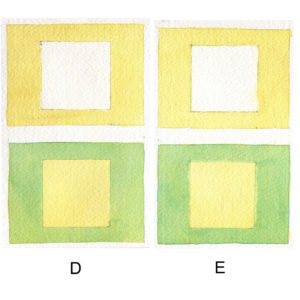
5 D: Top, one coat of QoR Masking Fluid applied and dried before application of watercolor, removed when the yellow paint was dry. Bottom, one coat of Masking Fluid applied over the dry yellow wash and allowed to dry, removed once the green glaze was dry.
5 E: Top, one thick coat of QoR Watercolor Medium brushed on and allowed to dry before painting, then removed once the yellow was dry (removal process as described for Lift Aid in the article). Bottom, one thick coat of Watercolor Medium over yellow, removed once green glaze was dry.
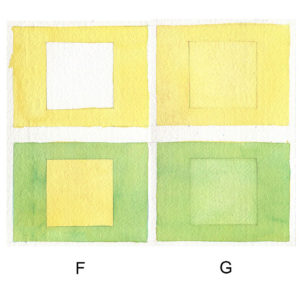
5 F: Painting around areas to preserve paper or color.
5 G: Trying to lift color after staining paints are dry.
About Cathy Jennings
View all posts by Cathy Jennings -->Subscribe
Subscribe to the newsletter today!

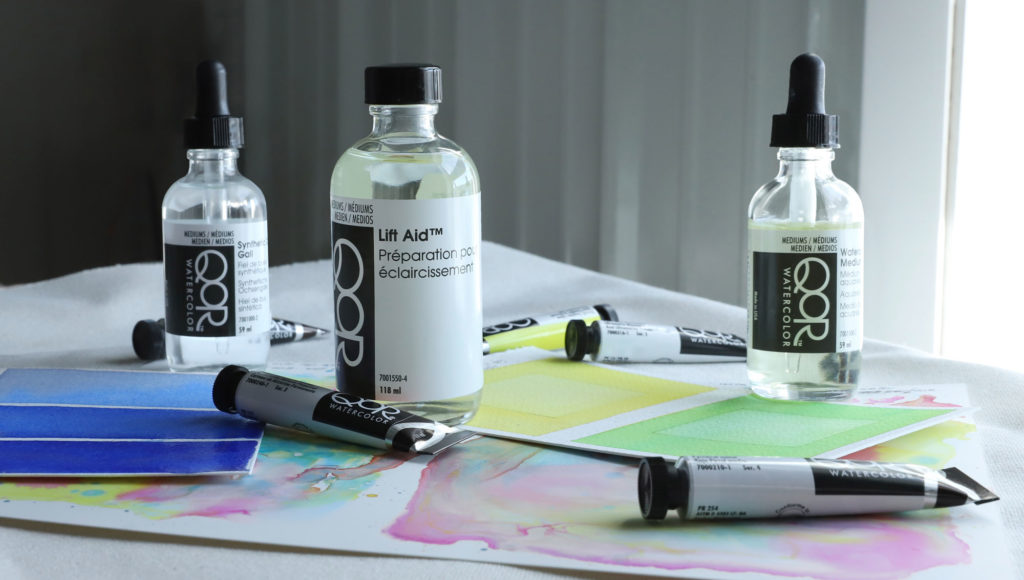
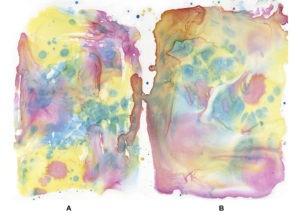
Can I paint oils on top of a drird QOR painting? I want to use QOR as a color trial layer prior to final oil painting.
Hello Ralph,
Yes, you can paint with oil paints over glazes and washes of watercolor. You might find our article “Acrylic or Watercolor Underpainting for Oils” to be of interest!
Happy painting,
Cathy
Hello,
Thank you very much for this article. You opened my eyes on using synthetic gall on Lanavanguard.
Your mediums give me great pleasure to use and I like the results.
Best.
Hello Geneviève,
We are glad you found our article helpful! We wish you much joy and success with your artwork.
Cathy
Good Day/Evening Ms. Cathy.
Concerning QoR’s Watercolor Medium, I have noticed something very interesting when I added it to my gum arabic-based gouache. In thick applications, it increases the flexibility of the resulting paint layers to the point that it prevents cracking and flaking-off. When prepared as a dilute solution, it enables gouache made with non-granulating pigments (such as phthalo blue) to make granulating washes. With this, I highly recommend using the watercolor medium even for gouache.
Hello Clarence,
Thank you for sharing your creative experiences with QoR Watercolor Medium. It is wonderful to hear how well the Medium increases the flexibility and granulation of your gouache applications!
Warm Regards,
Cathy
Hello Tracey,
Thank you for your questions! We consulted people in our Health and Safety Department and in our Lab in response to your questions, and we will answer them one by one below. QoR Ivory Black contains PBk9, a pigment created from carbonized cattle bones. Yes the Aquazol and surfactants used in QoR are petrochemical in origin. QoR paints can safely be washed down the drain. We have found that the Crash Kit does not produce satisfactory results with watercolors. QoR Payne’s Gray Payne’s Grey is very safe. Carbon Black, a pigment used in the color, is on the State of California’s list of chemicals “known to cause cancer”. However, that is a catchall, unfortunately, that doesn’t reflect the hazards of this product, nor the fact that the carbon black pigment we use is selected to be ultra-low in PAH content, the contaminants of potential concern in carbon black compounds. In addition, we have all our formulas reviewed by external toxicologist for their safety. You are always welcome to call Golden at 607-847-6154 or (toll free in the USA) 800-959-6543 and ask to speak to our Health and Safety team, they are happy to talk with artists with questions about our products. We hope this is helpful, and we wish you happy painting! Cathy
I have some expensive but older watercolor paper that seems to be irregularly sized, so that washes that should be smooth come out blotchy instead. Can any of your mediums or grounds be used to gently re-size questionable paper for watercolors?
This may be a separate question. I’ve also been hoping to find something to lightly seal colored paper made for pastels so it wouldn’t rumple when I use it for watercolors. I’m hoping for a transparent medium that would not affect the underlying tint of the paper.
Hello Georgia, thank you for your kind words! Our products are not intended to be used as paper sizing. It is possible that a dilute layer of any Watercolor Medium would be too water-sensitive to provide a good foundational sizing layer. Although we have not tested them, there are alternatives on the market. Holbein has a Multi Sizing Liquid which can be diluted for use in sizing watercolor paper. Natural Pigments has information on the history of paper sizing that includes directions for making and using a traditional animal gelatin sizing. Any paper that is likely to buckle when water is applied to the surface will probably need to be stretched before any product containing water is applied. Beware that thin papers do not have as much internal strength as heavier weight papers, and can tear while drying during the stretching process. After the paper dries and before it is released from stretching, a water-based size or a translucent product like Golden Pastel Ground (diluted with 20-40% water) could be applied. Pastel Ground is not transparent, but it will be more translucent once diluted. We would recommend experimenting with a few sheets of paper to see if the results are acceptable. We hope this is helpful, and we are reachable at [email protected] when you have more questions.